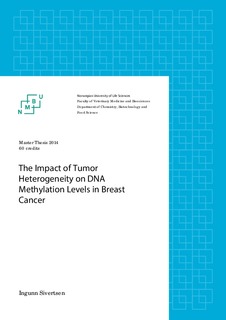| dc.description.abstract | Breast cancer is a heterogeneous disease with different clinical outcome. Tumor heterogeneity can be divided into inter-tumor heterogeneity representing variations between tumors from different patients and intra-tumor heterogeneity representing variations within a single tumor. Understanding the role of heterogeneity in tumor evolution and treatment response is important to give the most accurate diagnosis and treatment for each breast cancer patient. DNA methylation is an epigenetic mechanism important for normal development. Alterations in DNA methylation pattern which might affect gene expression has been observed in breast cancer. Since DNA methylation might influence the gene expression, it might also influence the phenotype. Thus, DNA methylation might contribute to the tumor heterogeneity observed at a phenotypical level. Studies have looked at among other DNA methylation in regard to development, survival and treatment of breast cancer. Few studies have looked at the association between tumor heterogeneity and DNA methylation level in breast cancer. The main aim of this study, designed as a pilot study, was to investigate this association. More specifically the aim was to study the relationship between fraction of tumor cells/tumor percentage and DNA methylation level. Additionally the aim was to study the difference in DNA methylation level between subpopulations with different CD24/CD44 expression patterns within a cell line and between subpopulations with the same CD24/CD44 expression patterns across cell lines with different molecular subtype. 113 bulk tumors (containing tumor cells and surrounding tissue), 3 macrodissected tumors and cell lines sorted into different subpopulations based on phenotype (expression of CD24 and CD44) were used in the present study. Genome-wide DNA methylation data and estimated tumor percentage were avaible for the bulk tumors and DNA methylation analysis of the macrodissected tumors and subpopulations within cell lines was performed by pyrosequencing. In this study, it was shown that the infiltrating non-neoplastic cells influence the measured DNA methylation level for many CpGs and genes. The genome-wide correlation analysis of 113 bulk tumors showed that the DNA methylation level of CpGs in around 1/3 of the genes in the human genome were associated to tumor percentage. For the macrodissected tumors it was shown that the DNA methylation level of most genes was associated with the amount of tumor cells in at least one of the tumors. The results of the correlation analysis and pyrosequencing corresponded well for the overlapping CpGs. For the macrodissected tumors the DNA methylation level of more genes was related to the amount of tumor cells in the basal-like tumors than in the luminal tumor. Besides, greater difference in DNA methylation level between the regions was observed in the basal-like tumors. However, of the 113 samples used in the genome-wide correlation analysis, the majority of the samples were luminal tumors. It is therefore likely that infiltrating non-neoplastic cells influence the measurements of DNA methylation level in luminal tumors as well. These findings might pose a challenge for interpretation of studies that use bulk tumors. This might hamper DNA methylation studies like the investigation of DNA methylation as a biomarker, classification of tumors based on the methylation profiles of breast cancer genes and the investigation of drugs for modifying the DNA methylation signal. Further studies should be performed with more samples covering CpGs in larger part of the genome to explore the extent of this tendency. If the same tendency is seen in further studies, it might affect how DNA methylation studies will be performed and interpreted in the future. Different methylation levels between samples of the same subpopulation within the same cell line (replicates) were revealed for RASSF1A and FOXC1. Due to too high variation between the replicates, the results weren’t trustworthy. The only difference between the replicates is that they had been cultured separately. Studies have shown that epigenetic changes, including DNA methylation, may occur during cell culturing. Further studies should be done to enlighten this area. | nb_NO |
